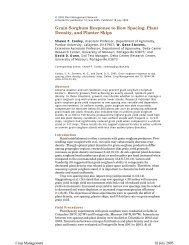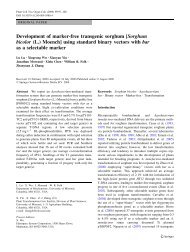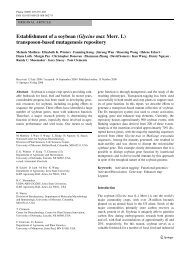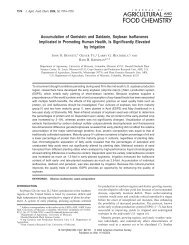Assessment of Indigenous Nepalese Soybean as a Potential ...
Assessment of Indigenous Nepalese Soybean as a Potential ...
Assessment of Indigenous Nepalese Soybean as a Potential ...
Create successful ePaper yourself
Turn your PDF publications into a flip-book with our unique Google optimized e-Paper software.
5492 J. Agric. Food Chem., Vol. 54, No. 15, 2006 Krishnan et al.<br />
Figure 2. Comparison <strong>of</strong> seed protein pr<strong>of</strong>iles <strong>of</strong> Williams 82 and Sathia by 2-D PAGE: (A, C) Sathia; (B, D) Williams 82. Isoelectric focusing <strong>of</strong> proteins<br />
w<strong>as</strong> first performed using either pH 4−7 (A, B) orpH6−11 (C, D) narrow-range IPG strips followed by SDS-PAGE on a 13.5% gel. The gels were<br />
stained with Coom<strong>as</strong>sie blue. Protein spots were excised digested with trypsin and the resulting peptides analyzed using MALDI-TOF-MS (Table 1).<br />
Comparative Analysis and Identification <strong>of</strong> Williams 82<br />
and Sathia Seed Protein Components by High-Resolution<br />
2-D PAGE and MALDI-TOF-MS. To elucidate fully the<br />
differences between the <strong>Nepalese</strong> cultivar Sathia and the North<br />
American cultivar Williams 82, we performed comparative<br />
analyses <strong>of</strong> seed proteins resolved by 2-D PAGE. Our initial<br />
analysis w<strong>as</strong> performed using immobilized pH gradient (3-<br />
10) (IPG) gel strips (Figure 1). IEF in this pH range gave limited<br />
resolution <strong>of</strong> the various isoelectric forms <strong>of</strong> the glycinins and<br />
β-conglycinin subunits. To improve separation <strong>of</strong> the protein<br />
spots IEF w<strong>as</strong> performed with IPG strips ranging from pH 4 to<br />
7(Figure 2A,B) and from pH 6 to 11 (Figure 2C,D). Resolution<br />
<strong>of</strong> β-conglycinin subunits and acidic glycinin subunits w<strong>as</strong><br />
significantly enhanced when the proteins were subjected to IEF<br />
using the pH 4-7 IPG strip (Figure 2A,B). Similarly, the use<br />
<strong>of</strong>apH6-11 gradient enabled resolution <strong>of</strong> the acidic glycinin<br />
polypeptides (Figure 2C,D). Several <strong>of</strong> the protein spots<br />
identified by MALDI-TOF-MS are listed in Table 1. Thirtysix<br />
protein spots representing the different isoelectric forms <strong>of</strong><br />
the glycinins and β-conglycinin were identified in this study.<br />
The <strong>Nepalese</strong> cultivar Sathia w<strong>as</strong> either deficient in or contained<br />
low amounts <strong>of</strong> glycinin G4/A5A4B3 precursors (spots 25-<br />
28) and glycinin G1/A1aBx subunit (spot 9) (Figure 2). In<br />
contr<strong>as</strong>t, Sathia accumulated higher amounts <strong>of</strong> glycinins G2/<br />
A2B1 precursor (spot 17) and glycinins subunit G3/A1ab1B<br />
(spot 21). Interestingly, Sathia also contained several protein<br />
spots that were identified <strong>as</strong> proglycinins (spots 23 and 24),<br />
which were not seen in Williams 82 (Figure 2). The contribution<br />
<strong>of</strong> these unique protein spots present in either Sathia or Williams<br />
82 to the total protein content w<strong>as</strong> quantified using scanning<br />
l<strong>as</strong>er densitometry in conjunction with s<strong>of</strong>tware algorithms. The<br />
relative concentration <strong>of</strong> the selected protein spots is shown in<br />
Table 2. This table clearly shows that the marked heterogeneity<br />
in the seed storage protein pr<strong>of</strong>iles <strong>of</strong> the <strong>Nepalese</strong> cultivar<br />
Sathia and the North American cultivar Williams 82.<br />
Amino Acid Composition <strong>of</strong> <strong>Nepalese</strong> <strong>Soybean</strong> Cultivars.<br />
The seed storage protein content <strong>of</strong> the <strong>Nepalese</strong> soybean<br />
cultivars is significantly higher than that <strong>of</strong> the North American<br />
cultivar Williams 82. To <strong>as</strong>certain whether the incre<strong>as</strong>ed protein<br />
content is accompanied by enhanced protein quality, we<br />
determined the amino acid composition <strong>of</strong> these cultivars (Table<br />
3). The arginine content <strong>of</strong> the <strong>Nepalese</strong> seed storage protein<br />
ranged from 7.7 to 8.1%, which w<strong>as</strong> 5-10% higher (P e 0.05)<br />
than the 7.4% expressed in Williams 82. Seed storage proteins<br />
in Karve and Seti contained more cysteine than Williams 82.<br />
Cysteine accounted for 1.64% <strong>of</strong> the total amino acids in Seti<br />
and 1.66% in Karve, 6 and 7% more, respectively (P e 0.05),<br />
than found in Williams 82.<br />
Restriction Fragment Length Polymorphism (RFLP) in<br />
the Genes Encoding 11S Storage Proteins. Southern hybridization<br />
w<strong>as</strong> used to determine the levels <strong>of</strong> variation in the DNA<br />
sequences <strong>of</strong> the seed protein genes among the soybean<br />
accessions under investigation. Glycinin, an 11S globulin,<br />
accounts for >50% <strong>of</strong> the total soybean seed protein. Five major<br />
genes, encoding the different subunits <strong>of</strong> the hexameric glycinin<br />
proteins, are cl<strong>as</strong>sified into two groups b<strong>as</strong>ed on DNA sequence








